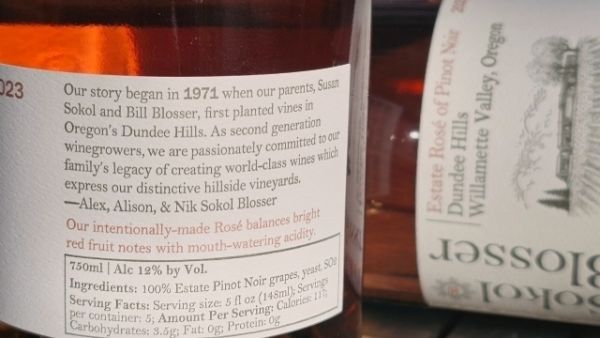 Last week, Willamette Valley’s Sokol Blosser announced that it was adding an ingredients list to its wine labels. The change starts with the winery’s just-released 2023 Estate Rosé of Pinot Noir.
Last week, Willamette Valley’s Sokol Blosser announced that it was adding an ingredients list to its wine labels. The change starts with the winery’s just-released 2023 Estate Rosé of Pinot Noir.
“It’s something that I’ve been thinking about for a few years,” says Alex Sokol Blosser, president of Sokol Blosser. “It addresses a transparency issue that I think younger generations in particular are interested in.”
The ingredients list for the winery’s 2023 Estate Rosé reads simply: “100% Estate Pinot Noir grapes, yeast, SO2.” The label also includes servings per container (5), calories per serving (117), carbohydrates (3.5), fat (0), and protein (0).
Generally speaking, the wine industry has long resisted putting an ingredients list on wine labels. Sokol Blosser says there are practical reasons for doing so.
“Some people on our team have diabetes,” he says. “Anytime they put something in their body, it really depends on the carbs and the sugar. They need that piece of information, and that’s not currently on a bottle of wine.”
Additionally, some people simply want to know what they are putting into their bodies. That might, or might not, impact buying decisions.
“Sometimes I think if people know that if they want to look at the ingredients they can, it makes them feel more comfortable with the product,” says Sokol Blosser.
There are myriad reasons why the industry has resisted ingredient labeling. While the ingredients list for some wines, such as the Sokol Blosser rosé, are quite simple, others might be considerably more complicated, particularly for mass produced wines.
The Alcohol and Tobacco Tax and Trade Bureau (TTB) has a long list of approved substances that may be added to wine. It also has a list of treating materials and processes that can be used for domestic wine production. Surely there are items on these lists that large wineries – and also some highly-regarded, smaller producers – would prefer not to list on a label.
Additionally, deciding what to include on an ingredients list might not always be straightforward. There are substances, such as fish bladders, egg whites, and copper that are used in winemaking processes, such as clarification, but subsequently removed from the wine. There are also processes, such as cold stabilization, where a variety of different techniques might be used that could impact the ingredients list.
“Typically you cold stabilize your white wines. You chill down the tank and add cream of tartar,” Sokol Blosser explains. “Now this can be done chemically, and it’s a huge time saver and a huge energy saver. It’s been great for the industry.”
Whenever there is something on the label that isn’t necessarily straightforward, Sokol Blosser is considering adding a QR code where people can learn more about the substance. “If you want to add Mega Purple, explain that,” Sokol Blosser says. “Maybe it isn’t as scary as you think it’s going to be.”
Overall, Sokol Blosser is easing into listing ingredients. It starts with the winery’s new rosé and will continue with other wines to be released in the spring.
“This will be a trial,” Sokol Blosser says. “We’re gonna get feedback. I’m sure we’ll hear from some other wineries saying ‘Why the f are you doing that?’”
While Sokol Blosser is leading on this issue in Willamette Valley, the winery believes that this change is coming more broadly. Though the TTB, like any governmental agency, moves glacially slow, it seems likely to mandate ingredient lists in the future. When remains uncertain.
“We do believe that ingredient labeling and nutrition data are going to be mandated by the TTB, so we want to get ahead of that,” Sokol Blosser says. “But we also see that this is something that we in the industry probably need to do anyways.”
Northwest Wine Report is wholly subscriber funded. Please subscribe to support continued independent content and reviews on this site.
To receive articles via email, click here.







I think this is a great idea, and with a wine industry grappling with how to be more relevant to younger consumers, this should be near the top of the list. You only need to watch young people shop in a grocery store. They constantly look at the ingredient and nutrition labels because they’ve grown-up with a dramatically heightened awareness of what they are eating and drinking. Just look at how food is marketed to young people these days! It probably won’t be long before there are carbon emission labels on packaged food products too.
It doesn’t need to be boring either, winemakers could use it to tell a brief story in a few sentences about how the wine is made. This is often lacking on most bottles, and it doesn’t take much space on a label to do this. Transparency is a modern marketing tool in an age when people have near limitless access to information.
Welcome to the team Sokol Blosser!
We have been ingredient labeling for over a decade.
I don’t believe alcoholic beverages should be exempt from mandatory ingredient labeling. Easy for us because we have never had more than four.
I prefer not to have unknown substances in my food. Wine is part of my meals.
Zero Pesticide, ingredient labeled wines since 2012.
Paul Vandenberg
Paradisos del Sol Winery and Organic Vineyard